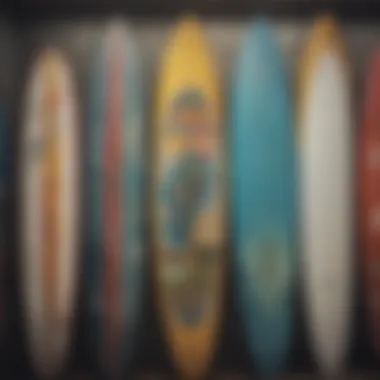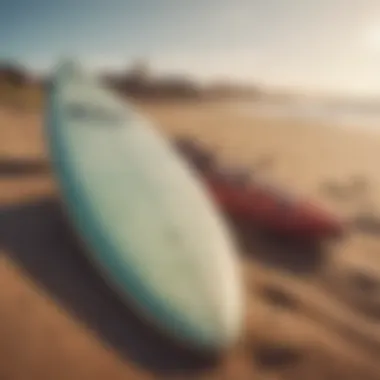Exploring the Depths of Surfing Culture and Practices


Intro
Surfing is not just a sport; it is a way of life, deeply entwined with the rhythm of the ocean and the culture of coastal communities. As waves crash onto the shore, they carry with them stories of adventure, camaraderie, and environmental consciousness. This guide takes a closer look at the various components of surfing culture—from mastering surfboarding techniques to understanding the essential gear that every surfer needs.
Whether you are just stepping on a board for the first time or you're a seasoned pro hitting the waves during dawn patrol, this resource is designed to enhance your connection to not only the sport but also the vibrant community that surrounds it.
With a wealth of information on everything from eco-friendly practices to navigating the surfing scene, we aim to inspire a deeper appreciation of the ocean and our responsibility to protect it. Let's dive into the world of surfing and discover what makes this culture so rich and impactful.
Surfboarding Techniques
Understanding surfboarding techniques can be the line between a thrilling ride and a wipeout. Knowing how to maneuver can drastically enhance your experience, whether you’re a beginner or a veteran.
Beginner Tips for Mastering the Basics
- Paddling: Start by lying flat on your board. Use a smooth and steady stroke to navigate through the water. It's important to develop a rhythmic motion here; paddling too fast only tires you out.
- Positioning: Finding the sweet spot on your board is crucial. Too far back, and you’ll nose dive. Too far forward, and you’ll struggle to catch waves.
- Pop-Up: When a wave lifts you, practice your pop-up technique. Start from lying down, push yourself up to your knees, then explode up into a standing position. Timing is essential. Practice on land until you’re comfortable.
- Stance: Keep your feet shoulder-width apart. Bend your knees slightly and maintain a low center of gravity. This stance provides better balance and control.
Advanced Techniques for Seasoned Surfers
For experienced surfers, it’s about fine-tuning those skills and pushing boundaries. Here are some techniques to master:
- Carving: This is all about creating an arc on the wave. Shift your weight appropriately from heel to toe to create a fluid motion while riding.
- Tube Riding: A tricky skill, it involves slipping inside the breaking wave. Timing is everything, as you need to position yourself just right as the wave curls.
- Aerials: This high-flying technique requires courage. As you ride, use the wave’s lip to launch yourself into the air. It demands a mix of balance, timing, and precision landing.
"A surfer is a poet who rides on the water, capturing the essence of the ocean in their soul."
Surfboard Equipment
Selecting the right board and gear can substantially impact your performance and enjoyment. Here’s what you need to know:
Reviews of the Latest Surfboards on the Market
There’s a multitude of surfboards to choose from, each designed for different styles and skill levels. Some popular models include:
- The Catch Surf Beater: Ideal for short, playful rides, this board is perfect for beginners or fun-loving surfers looking for a unique experience.
- Channel Islands Mini Fish: A great choice for intermediate surfers, offering a combination of stability and speed.
- Firewire Dominator: This board offers performance for various conditions and is a favorite among advanced surfers who enjoy versatility.
Essential Gear for Every Surfboarder
Aside from the board itself, here’s a list of important gear to consider:
- Leash: Ensures your board stays connected to you. Always check it for wear before you head out.
- Wetsuit: Depending on your local temps, a good wetsuit is crucial for comfort and protection.
- Rash Guard: This adds a layer of protection against sunburn and prevents skin irritation from the board.
- Wax: Properly waxing your board improves grip, ensuring you don’t slip off during crucial moments of your ride.
To explore further into these fascinating topics or connect with fellow enthusiasts, resources like Wikipedia, Britannica, and community discussions on platforms such as Reddit can provide incredible insights.
Understanding the Surfing Culture
Diving into the surfing culture is akin to plunging into an ocean teeming with vibrant life; it is an intricate tapestry woven over decades, colored by history, geography, and individual experiences. Understanding this culture is crucial for surfers, instructors, adventurers, and eco-enthusiasts alike, as it encapsulates the essence of what draws individuals to the waves. Surfing is more than a sport; it’s a lifestyle that embraces freedom, connection, and reverence for nature. This section explores key elements that define surfing culture, illustrating how they impact both the community and the environment.
Historical Evolution of Surfing
Surfing traces its roots back to ancient Polynesia, where it was not merely a recreational activity but a significant aspect of the culture itself. The first documented instance occured around 1778 when Captain James Cook recorded the surf riding of the native Hawaiians. This early form of surfing was often tied to social status, with skillful surfers earning respect and recognition within their communities.
As surfing spread across the globe, its historical evolution took various paths. In the early 20th century, the sport transformed in California with the introduction of longboards, creating a fusion of outdoor fun and surfer lifestyle that captured the imagination of the American public. Over the decades, innovations in technology and changes in societal norms continued to shape surfing, leading to the refinement of techniques and the emergence of surf culture in places like Australia, Brazil, and Europe. This evolution reflects a broader narrative of globalization and cultural exchange, as surfing adapted and integrated into diverse communities worldwide.
Global Influence of Surfing
Surfing has transcended its origins to become a global phenomenon, significantly influencing various aspects of music, fashion, and art. The rhythmic sounds of surf rock, epitomized by bands like The Beach Boys, evoke the carefree spirit of the beach and have become synonymous with the surfing lifestyle.
Fashion-wise, surf culture has pioneered trends that redefine casual wear, from board shorts to vibrant wetsuits. These items not only serve practical purposes but also act as a canvas for self-expression, showcasing individual personalities and regional influences. Moreover, art inspired by surfing spans across continents, evident in works that capture the motion of waves or portray iconic surfing locales.
As such, surfing also plays a role in environmental awareness. Surfers, having a unique bond with the ocean, often take the lead in advocating for ocean conservation and responsible eco-practices within their communities. Groups like Surfrider Foundation are emblematic of this movement, emerging from the surf culture to address beach clean-ups, legislation, and developing sustainable practices.
Surfing as a Lifestyle
For many, surfing evolves into a lifestyle characterized by its philosophies, camaraderie, and a deep connection to nature. It is not just about riding waves; it is about the community it fosters. Surf sessions often begin and end with shared stories, laughter, and the occasional quiet moment of reflection while waiting for a wave. These connections forge friendships that can last a lifetime. Surfing provides a sense of belonging to those who embrace it, regardless of their skills or experience.
Moreover, surfing as a lifestyle is inherently tied to a mindset of adventure and spontaneity. Surfers often find themselves traveling to discover new waves, forging bonds with locals, and immersing themselves in different cultures along the way. This search for the perfect wave can lead to unforgettable memories and life-changing experiences.
"Surfing is not just a sport; it’s a way of life, a mindset that connects you to the planet and its vast beauty."
Each aspect of surfing culture, from its rich history to its global impact and lifestyle philosophies, illustrates how deeply intertwined it is with individual and communal identities. Understanding the cultural nuances prepares surfers not just to ride waves, but to ride the currents of a much larger sociocultural movement.
Essential Surfing Equipment
The world of surfing is as much about the gear as it is about the waves themselves. Understanding essential surfing equipment is crucial not just for performance, but also for safety and enjoyment of the sport. Each piece of equipment serves a specific purpose and contributes to an overall better experience in the water. Choosing the right gear can make a significant difference, whether you’re a beginner easing into the sport or a seasoned surfer pushing your limits.
Types of Surfboards


Shortboards
Shortboards are the go-to choice for many experienced surfers, especially for those who favor performance. The key characteristic of shortboards is their length, typically ranging from 5 to 7 feet. This shorter length allows for greater maneuverability and quick turns, making it easier to surf steep waves. Their design also offers less buoyancy, which can be both an advantage and a drawback: it's easier to perform advanced tricks but tougher to paddle into waves. For many, this balance is what makes shortboards a popular and beneficial choice. However, a surfer’s skill level plays a significant role in the choice of this board. Beginner surfers may find shortboards challenging, as they require a higher level of skill and balance.
Longboards
In contrast, longboards tend to be larger, often measuring between 8 and 12 feet. They’re not just about size; they offer a smooth ride that is ideal for cruising. A critical advantage of longboards is their stability, making them a suitable option for beginners and those looking to take their time in smaller, mellow waves. Their unique feature lies in their design: the wider nose and rounded tail make for easy paddling and riding. While they might not be the first choice for thrill-seekers chasing big waves, longboards provide a classic surfing experience, appreciated by many surfers who love the art of noseriding and laid-back surfing styles.
Fish Boards
Fish boards have made a name for themselves as a hybrid that combines elements of both shortboards and longboards. These boards are typically shorter and wider than shortboards, allowing for excellent paddling and speed, especially in smaller waves. The key characteristic of fish boards is their unique tail shape, which provides increased maneuverability and responsiveness. This makes them a beneficial option for surfers looking for versatility. However, fish boards can sometimes take some getting used to due to their different handling characteristics. Surfers may find the wide tail beneficial for riding small waves, yet frustrating when they switch back to a standard shortboard.
Wetsuits and Gear
Material Choices
The right material can make all the difference in your comfort out on the waves. Modern wetsuits often utilize neoprene, known for its insulating properties, making it a popular choice among surfers. When it comes to material choices, flexibility is key; stretchy wetsuits allow for better movement while paddling and riding. However, not all wetsuits are created equal. The thickness of the material usually correlates with water temperature, meaning thicker suits are great for chillier waters, but can be restrictive in warmer climates. Ultimately, a well-chosen material sets the tone for how much you enjoy your surf session.
Size and Fit
Selecting the right size and fit is another crucial factor. A wetsuit that’s too tight can be uncomfortable and restrict movement, while a loose suit allows water to flow in, chilling you quickly. The perfect fit hugs your body while allowing for that much-needed mobility. Note that most brands offer size charts to guide your choice, but it's often beneficial to try on different styles. Surfers should consider their body shape and the primary conditions they plan to surf, leading to a well-informed decision on size and fit.
Seasonal Variations
Surf conditions fluctuate throughout the year, and so does the ideal wetsuit. Seasonal variations dictate what gear to bring on your surf trip. In summer, surfers may opt for thinner wetsuits or even shorties, while winter conditions often require thicker suits with hoods and booties. This adaptability ensures both comfort and performance regardless of the season. Surfers must pay close attention to the weather forecasts and water temperatures to make informed gear choices for the best experience.
Accessories for Surfers
Leashes
Among surfing accessories, leashes are essential for safety. A leash connects the surfer to their board, preventing the board from drifting away after a wipeout. The durability and thickness of a leash should match the size of the surfboard and the size of the waves. While leashes are often overlooked, they are pivotal in maintaining control in rough conditions. The unique feature here is the coiled design, which helps keep the leash from dragging in the water during a wave ride. Understanding the significance of leashes can greatly enhance a surfer’s experience, providing peace of mind when in the surf.
Fins
Fins play a crucial role in how a board rides. The type and size of fins can dramatically alter a surfer's experience. For instance, larger fins may offer better grip and stability, while smaller fins can provide enhanced maneuverability. Each fin setup (single fin, thruster, quad) serves different surfing styles and wave conditions, making it important for surfers to choose accordingly. The unique feature of fins is how they influence the dynamics of a surfboard on the water, affecting turns, spins, and acceleration.
Rash Guards
Rash guards protect surfers from irritation and sun exposure. Made with stretchable material, they’re designed to fit snugly without restricting movement. These garments are especially beneficial in warmer waters where wetsuits might be overkill. The additional layer not only reduces the risk of rashes from board contact but also provides some sun protection. The uniqueness of rash guards lies in their versatility; they can be worn alone or under wetsuits, making them a staple accessory for any surfer.
In summary, the right essential surfing equipment can enrich the surfing experience and enhance performance, making it paramount for all surfers to understand their choices.
Techniques for Improving Your Surfing Skills
Understanding various techniques for improving your surfing skills is not just pivotal for enhancing performance but also for fostering a deeper connection with the sport itself. Mastering these techniques can lead to a more immersive experience in the ocean, and it elevates one’s ability to engage in the surfing community. Surfers, whether beginners or seasoned riders, often seek improvements in their skills to navigate waves more efficiently, manage challenging surf conditions, and push themselves to explore new surfing maneuvers.
Basic Surfing Techniques
Starting with the fundamentals, basic surfing techniques are crucial for all surfers, regardless of their skill level. Learning how to paddle effectively, position oneself on the board, and properly pop up to stand can make all the difference between riding a wave or wiping out. These techniques build a solid foundation and foster confidence in the water, which is vital for progression.
Paddling Technique
Paddling is often overlooked but is the backbone of effective surfing. Proper paddle stroke can increase speed and maneuverability. A technique called the "high elbow" style allows for longer and more powerful strokes, helping in catching waves more efficiently.
Advanced Maneuver Techniques
Once mastered the basics, surfers often wish to delve into advanced maneuvers that truly showcase their skills. These techniques not only contribute to the surfer’s repertoire but also add style and flair to their riding.
Cutbacks
Cutbacks are vital for maintaining speed and flow on waves, allowing surfers to take control and direct their ride. This maneuver involves turning back toward the breaking section of the wave after initially riding away, essentially a change of direction that keeps the surfer in the power zone. This technique is beneficial because it helps surfers maintain their speed while repositioning for the next wave section.
Key Characteristic: The cutback requires precise timing and balance to execute correctly.
Advantages: It enhances wave riding ability and boosts confidence in managing speed.
Floaters
Floaters can enhance a surfer's ability to ride steep sections of a wave where balance is critical. This maneuver allows surfers to ride over the lip of the wave momentarily before dropping back down. Floaters can be tough but offer a rush when executed well.
Key Characteristic: It showcases a surfer's ability to navigate tricky sections of waves creatively.
Advantages: Successfully landing a floater often surprises spectators and reflects a high skill level.
Aerials
Aerials represent the crossroads of skill and showmanship in surfing. This maneuver requires a surfer to launch off the wave and perform tricks in the air before landing back on the wave. Aerials are increasingly seen in competitions, showcasing a surfer’s agility and creativity.


Key Characteristic: The aerial requires a good combination of timing, wave selection, and commitment.
Advantages: They elevate a surfer's status in competitions while thrilling audiences.
Mental Aspects of Surfing
Beyond the physical techniques, the mental aspects of surfing play a crucial role in performance and enjoyment of the sport. The mental game can differentiate a good surfer from a great one.
Focus and Visualization
Focusing on the moment and visualizing success before a ride can directly influence the outcome. Surfers who practice visualization often find greater success in executing their desired maneuvers.
Key Characteristic: Visualization prepares both the body and mind, reducing anxiety and fear.
Advantages: It boosts self-confidence and creates a positive mindset in challenging conditions.
Overcoming Fear
Fear can be a significant hurdle in the surfing journey. Learning to manage and overcome fear is crucial not only for safety but also for personal growth within the sport. Surfers often experience fear of big waves or wipeouts, which can hinder their progression.
Key Characteristic: Understanding fear can lead to better control and cognitive management.
Advantages: Overcoming fear fosters resilience and leads to richer surfing experiences.
Building Confidence
Confidence is the glue that holds together all surfing elements. A surfer’s ability to approach new challenges stems from self-assurance in their skills.
Key Characteristic: Building confidence involves celebrating small victories and consistent practice.
Advantages: As one builds confidence, it opens up new possibilities for further experiences and maneuvers in surfing.
"The ride is only as good as the connection you have with the waves and the confidence you bring into it."
Surf Spot Recommendations
Surfing plays out not just on the waves but also in the very locations that define the experience. Identifying the right surf spots can mean the difference between a fulfilling day on the water and a frustrating one. Surf spots are crucial for both skill development and community engagement. Knowing where to go, understanding the local conditions, and respecting the culture of the place can enhance any surfer's journey. Here, we explore some top spots, hidden gems, and what to keep in mind regarding surf conditions.
Top Surf Destinations Worldwide
Hawaii
Hawaii is often regarded as the cradle of surfing, rich in history and significance. It’s renowned for its powerful waves, especially on the North Shore of Oahu which is considered a surfer's paradise. The swells here can reach up to 30 feet during winter months.
The unique characteristic of Hawaii lies in its diverse surf breaks. From the massive barrels of Pipeline to the mellow waves of Waikiki, it caters to surfers of all skill levels. This variety makes it an enticing choice for anyone looking to experience the full spectrum of what surfing has to offer. However, it’s important to be aware of the local etiquette; respect the locals and always hang loose.
Bali
Bali has gained a reputation as a surfing hotspot, offering stunning beaches and consistent waves nearly year-round. The island is often packed with surfers from all corners of the globe, creating a vibrant surf culture.
What makes Bali stand out is its affordability and access to beautiful locations like Uluwatu and Kuta. These spots provide not just excellent surfing conditions but also vibrant nightlife and cultural experiences. However, the popularity can also mean crowded line-ups, so patience and local knowledge are key to maximizing the surf experience here.
Australia
Australia is home to some impressive surf beaches, from the Gold Coast to Margaret River. Each area offers its own charm, with unique arrangements of surf breaks.
The key feature that makes Australia a sought-after location for surfers is the sheer diversity of conditions. Known for its picturesque landscapes and high-quality waves, it becomes a playground for both beginners and seasoned surfers alike. However, with its idyllic coastline, one should be conscious of marine life, including the presence of sharks at certain beaches, which can add a layer of unpredictability to the surf.
Hidden Gems for Adventurous Surfers
Secret Local Spots
Among the numerous well-known surf locations, there are hidden local spots that provide a more intimate, authentic surfing experience. These secret spots often have fewer crowds, and the waves can be just as good, if not better, than the mainstream beaches.
The characteristics of these places often include stunning natural habitats and an undiscovered sense of adventure. Surfing in these areas can foster a deeper connection with nature, while also forming a bond with local surfers who take pride in their less-traveled locales. However, finding these spots sometimes involves a bit of effort and respectful navigation through local customs.
Off-the-Grid Locations
For those looking to escape the hustle, off-the-grid locations offer a world of tranquil waves and scenic beauty. These spots may require a bit of a trek but can yield unforgettable sessions. Surfing in less populated areas often leads to a sense of solitude and a chance to truly connect with the ocean.
The unique feature of these locations usually involves untouched beaches and a slower pace of life. Conditions can be variable and at times challenging, so it's vital to do thorough research and possibly team up with locals to ensure safety and to learn about the best times to surf.
Surf Conditions and Seasonal Insights
Understanding surf conditions is paramount for a successful surf outing. Various factors like tide, wind, and swell direction can significantly affect the quality of waves. Being aware of seasonal changes can help surfers know when to hit the water for the best experience.


- Know the tides: Tides fluctuate and knowing if it’s high or low tide can make or break your session.
- Swells may vary: Different swells come from different directions and knowing how they interact with the coastline is crucial.
In summary, knowledge of surf spots, whether popular or hidden, combined with an understanding of conditions, greatly enhances the surfing experience, fostering not just skills but also a strong sense of community and ecological awareness.
Environmental Consciousness in Surfing
The waves have a rhythm, a language that speaks to those who ride them. Yet, beneath this dance of surfboards and sea foam lies a pressing concern: the health of our oceans and beaches. Environmental consciousness in surfing isn’t just a trend; it’s a moral obligation for every surfer who cherishes the water. Given the rising challenges posed by pollution, climate change, and over-exploitation of resources, understanding and embracing eco-friendly practices is vital. This section will explore how surfers can honor the ocean while enjoying the sport they love.
Sustainable Practices for Surfers
Eco-Friendly Surfboards
Eco-friendly surfboards are crafted with sustainable materials and production methods, aiming to reduce the negative environmental impact often associated with traditional boards. These boards often feature biodegradable resins and recycled components, which not only lessen waste but also promote a circular economy within the surfing industry.
One remarkable aspect of eco-friendly surfboards is their lightweight designs, which can enhance performance in the water. For example, boards made from bamboo or recycled EPS foam are becoming increasingly popular, serving as strong alternatives to conventional fiberglass and polyurethane boards. Their usage not only helps keep landfills at bay but also tackles the issue of toxic chemicals often involved in surfboard production.
However, these eco-friendly boards come with their own set of challenges. Some surfers may find that they are slightly less durable than their traditional counterparts, requiring more careful handling. It’s a trade-off many are willing to make for the sake of sustainability.
Plastic-Free Alternatives
In a world inundated with plastic waste, plastic-free alternatives for surfers are more than just options; they are a necessary step towards preserving the marine environment. From surf wax made without petroleum derivatives to reusable water bottles and bags crafted from natural fibers, these alternatives tackle the issue head-on, reducing dependency on materials that harm marine ecosystems.
The defining feature of plastic-free alternatives lies in their ability to decompose without leaving a mark on the planet. These products integrate seamlessly into a surfer's life, making it easy to choose eco-friendly options without sacrificing performance. Surfers can now enjoy their sport fully aware that their choices align with their environmental values. However, the initial costs of such products can sometimes deter surfers from making the switch, although the long-term benefits for the ocean and waves far outweigh these concerns.
Conservation Efforts in Surf Communities
Many surfing communities around the globe have taken up the mantle of conservation efforts, becoming vocal champions for the oceans they cherish. From local beach clean-ups to creating awareness about marine preservation, these endeavors are crucial. Community organizations often organize events that not only engage surfers but also educate them on the importance of clean environments.
Connected with conservation are initiatives like ‘surfers against sewage’ and various local partnerships focused on marine biodiversity. Such efforts demonstrate that when surfers band together, they can make a sizeable impact. Utilizing social media channels like Facebook and forums such as Reddit, they spread their message far and wide, rallying more surfers to make conscious choices that protect our planet's waters.
Impact of Climate Change on Surfing
The looming threat of climate change poses vulnerabilities to surfing as a whole. Rising ocean temperatures affect wave patterns and biodiversity, while sea-level rise threatens coastal surf spots. Changes in wind conditions and increased storm frequency can lead to more turbulent water and degraded surf quality. This not only impacts the thrill of surfing but also alters the marine ecosystems that surfers rely on.
Surfers need to grasp the significance of climate change and become advocates for action. By participating in initiatives that focus on sustainability and environmental protections, they can champion the cause for a healthier planet. Supporting research and technology aimed at understanding and mitigating climate impacts can empower the surf community to lead in positive change.
"The ocean is not just a playground; it’s our lifeblood. By protecting it, we embrace our role as custodians of the coast."
In wrapping up this section, it’s clear that environmental consciousness is an integral part of surfing culture. By advocating for sustainable practices, engaging in conservation efforts, and addressing the challenges posed by climate change, surfers can ensure the waves remain pristine for generations to come. The choices made today can ripple out like waves, creating positive change for the surfing community and the planet.
Connecting with the Surf Community
Connecting with the surf community is at the heart of what it means to be a surfer. The camaraderie found among surfers fosters a unique bond, rooted in shared experiences and a profound respect for the ocean. This connection transcends geographical boundaries and social backgrounds, offering a sense of belonging that is hard to replicate elsewhere.
The benefit of engaging with fellow surfers is multifaceted. Firstly, it opens avenues for learning. More seasoned surfers often share invaluable tips and tricks, accelerating a newcomer’s learning curve. Conversing with others who share similar passions can unlock new perspectives on techniques and philosophies regarding both surfing and life.
Moreover, participating in the surf community cultivates tighter relationships not just on the water but beyond it. Friendships formed during ocean outings often turn into lifelong connections. These bonds can support surfers during challenging times, instilling a sense of trust and support that most don’t experience in other hobbies.
Additionally, being part of this vibrant community provides insights into local surf conditions. Local surfers can help navigate the waves better, pointing out patterns and spots that outsiders may overlook. Sharing stories around campfires after a day of surfing creates memories cherished for years. It’s these narratives that strengthen the community fabric, promoting a collective identity.
Understanding this, engaging socially through surfing forums or platforms like Reddit can deepen these connections, allowing surfers to discuss experiences, swap stories, and even organize local meet-ups. The importance of social media, in particular, cannot be understated; it’s a modern-day lifeline allowing surfers to remain in touch with their circle, share content, and celebrate each other's achievements.
"The ocean stirs the heart, inspires the imagination, and brings eternal joy to the soul." - Wyland
Social Media and Surf Culture
Social media has undeniably changed the way surfers interact. Platforms like Instagram, Facebook, and even specialized forums have become digital hangouts for surf enthusiasts. The immediacy with which surfers can share everything from stunning wave riding videos to product reviews turns individual stories into a global conversation.
Many pro surfers utilize their social media presence to guide and motivate budding athletes. This phenomenon can also inspire surfers to engage with their local environment responsibly. Posts promoting sustainable practices or whispers about meetings for beach clean-ups can influence others to take action, reinforcing a culture of awareness among surfers.
Surf Competitions and Events
Competitions are like a double-edged sword in the surfing world; they can be both exhilarating and anxiety-inducing. Such events not only showcase talent but also help in solidifying bonds within the community. Whether local competitions or international championships, each has its own flavor and significance.
Local Competitions
Local competitions are often seen as gateways for amateur surfers to showcase their skills. They bring together riders from the vicinity to compete on familiar waters, enabling them to push their abilities in a more relaxed environment. The key characteristic of these events is their accessibility, as they don’t require the hype and stress associated with major competitions.
Participating in local contests fosters a sense of fun and friendly rivalry. They serve as an excellent platform for surfers to meet fellow enthusiasts, learn from each other, and even gain recognition within the community. A unique feature of local competitions is the camaraderie that develops. Surfers share waves, tips, and laughs over the course of the day, making it a cherished experience beyond just competition.
However, local competitions can sometimes overshadow the notion of pure surfing joy with a competitive edge that may not suit every individual. The pressure, however subtle, can deter some newcomers from embracing the spirit of surfing fully.
International Championships
On the flip side, international championships are a spectacle. They put top-tier talents under the spotlight and create a buzz around them. An eye-catching aspect of such events is the diversity of surfers participating from all corners of the globe, bringing various styles and perspectives. The energy among participants and spectators alike is electrifying, providing an opportunity for national pride and suspenseful moments.
What makes international championships significant is the potential for sponsors and global recognition they afford. Surfers competing here can build their profiles and possibly turn their passion into a career.
Yet, the downside often lies in the rigid structure and sometimes expensive participation fees. This can deter less experienced surfers who might excel but lack the resources or connections to enter.
Building Relationships with Local Surfers
Regularly hitting the waves at the same spot leads to familiarity that can develop into meaningful associations with local surfers. Engaging with this close-knit community results in invaluable learning experiences. Experienced surfers often take the time to coach those new to the scene, providing tailored advice on tackling the unique challenges of local waves. This element greatly enhances one’s surfing journey, fostering growth and self-improvement.















